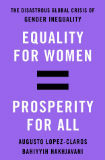
Equality for Women = Prosperity for All
Augusto Lopez-Claros and Bahiyyih Nakhjavani
320 pages, St. Martin's Press, 2018
In Equality for Women = Prosperity for All, Augusto Lopez-Claros and Bahiyyih Nakhjavani explore the many economic and social implications of global gender inequality. They delve into the current precarious position of women, who endure extreme rates of violence and reduced access to education and employment, and caution that the rapidly worsening effects of inequality will have devastating consequences for everyone if they continue unabated. Moving beyond purely ethical arguments, the authors contend that gender inequality is not just a moral failing; it is a waste of resources. In doing so, they lay out the case for making gender inequality a serious focus of economic planning.
Lopez-Claros and Nakhjavani address numerous modes of women’s subjugation, including population growth and female infanticide; violence against women in its many forms; work; the role of culture; rights, freedoms, and the legal system; and education for girls. In the final chapter, they connect the pieces of this puzzle to explore the true costs of these deficiencies.
The strength of Equality for Women = Prosperity for All is that it pushes the reader to think of economic efficiency from a new perspective, and to see the significant contributions that women make to the health and well-being of their countries. The book argues that costs to our global economy and our society “will mount calamitously” if we continue to ignore the oppression of women, a central barrier to economic prosperity. The authors explore the implications of leaving women out of the equation and quantify the costs, both social and economic, of the injustices waged against women.
While it may seem crass to put a price tag on sensitive issues such as female genital mutilation, domestic abuse, or murder, the authors cogently argue that quantifying the real cost impact of such atrocities can motivate the adoption of larger budgets to address these issues. To be sure, the book could have provided richer, more nuanced examples of the experiences of individual women to illustrate the subjects covered. But in the absence of individual accounts and experiences, it provides a more comprehensive, global view of policy and practice.
In a chapter titled “The Culture Question,” Lopez-Claros and Nakhjavani challenge skepticism about interventions relating to gender and culture. Here they unpack the fear of confronting the cultural origins of gender inequality that so frequently silences any push for progress.
As so often happens, when a discussion of human rights is linked to women, the focus shifts to the preservation of culture. The authors deconstruct this tendency, offering insights into how we can redefine culture through a lens of economic incentives, and cite the diaspora experience as an example. Once removed from country-specific economic constraints, many diaspora communities flourish, with women taking the lead in social and economic positions. This phenomenon demonstrates the important role that economic incentives play in shaping cultural expressions of gender norms. Lopez-Claros and Nakhjavani’s arguments in this chapter can empower policymakers to push back against the culture argument when attempting to institute system-wide change.
The authors do not provide a how-to guide for making change, nor do they delve into solutions for the issues that they articulate so effectively. I would very much like to read a follow-up that examines the various policy interventions that can create the transformation that Lopez-Claros and Nakhjavani are championing, in order to unlock the economic potential they herald.
This is an ideal book for policymakers who need to understand the broader picture of gender inequality and its impact. The authors use clear and expressive language, peppering the text with examples and cases from around the world. For individuals who may not have experience applying a gender lens to development issues, this book provides insights into the many ways that the oppression of women is tied to economic stagnation and too often shielded from policy interventions by arguments of national or cultural sovereignty.

